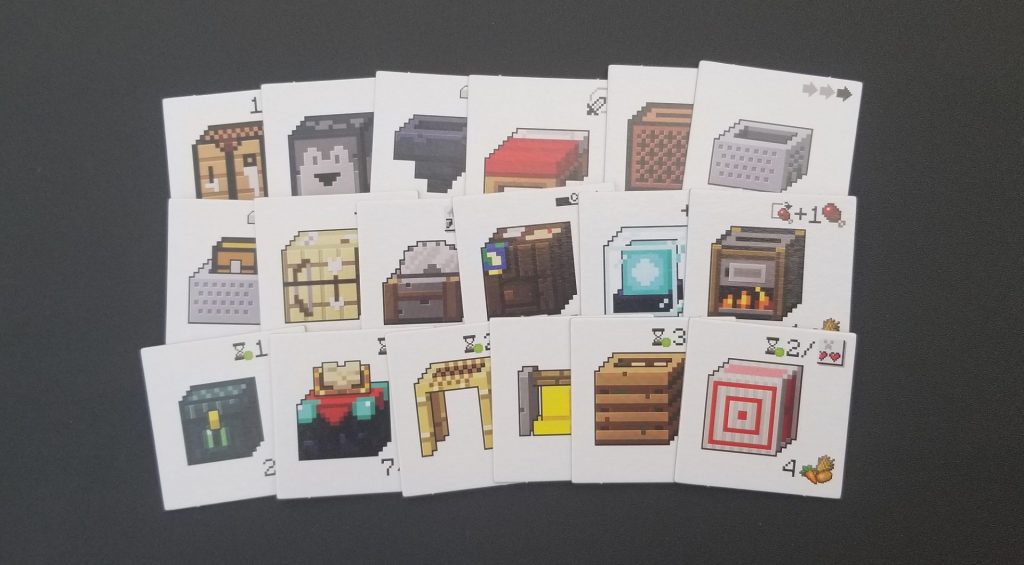NOTE: This review assumes you’re already familiar with Minecraft: Builders & Biomes. If you’ve never played it or just need a refresher on how it works, then check out our review.
The Minecraft: Builders & Biomes base game is an enjoyable experience for both Minecraft junkies, such as myself, and Minecraft plebes alike. Minecraft: Farmer’s Market Expansion (Farmer’s Market) aims to take those pleasant interactions from the base game and elevate them, while simultaneously addressing a few of the base game’s shortcomings. How does it do this and does it do it well? Read on and find out.
What’s New?
Farmer’s Market introduces a new resource into the game (wheat) along with the titular farmer’s market, a board loaded up with items printed on tiles that can be purchased by cashing in your wheat. These items provide powerful, game changing effects such as allowing you to remove a poisonous potato from your weapons deck, receiving victory points for performing specific actions in addition to what those actions would normally provide, as well as opportunities to score additional end game victory points.
Also included in this expansion are several new character standee options, new player aids to replace the ones in the base game, some starting Building tiles as well as some new Building tiles that are shuffled in with the Building tiles from the base game, and some yellow wheat resource cubes. Additionally, Farmer’s Market includes some new, double-sided scoring tiles to replace the ones in the base game. These tiles can be flipped to their 50 side once a player has completed a rotation around the score track. This was one of my beefs with the base game and I am glad to see it addressed here. What is not included, though, are any plastic bags to store things in.
Seriously, how hard is it to toss in a bag or two? Is that too much to ask?!
But I digress. Lack of baggies aside, Farmer’s Market’s svelte components list belies the monumental impact they have on the game as a whole. Farmer’s Market is to Minecraft: Builders & Biomes as Cities and Knights is to Catan, an expansion that so elevates the game and that is so easy to incorporate, that I will never play without it.
How Does It Work?
During setup, each player will receive a starting Building tile that features a field with a number of small squares printed on it. This tile is placed onto the player’s board in a location of their choosing, obscuring whichever biome is shown on the covered square. The small squares on the starting tile are filled with yellow wheat cubes.

The market board is set off to the side of the central display of face down Mob and Building tiles and seeded with several rows of randomly selected items (with the unused ones remaining in the box). The first row is always visible, but the second and third will only be revealed after the first and second of the three scorings.
In addition to the base game’s 5 possible actions–collect cubes, move, build, collect weapons, and fight monsters–there is now a 6th possible action: buy from the marketplace. As mentioned previously, each of the newly introduced items has a wheat cost associated with it (shown in the bottom right hand corner of the tile). This cost is paid to the supply directly from a player’s fields. Once paid for, the item is collected and kept in the player’s playing area where it immediately begins to provide its benefit.

So, you might be wondering, how do you get more wheat? Wheat is introduced by revealing and building the new Building tiles, each of which has multiple wheat locations on them. Once added to a player’s tableau, wheat is immediately added to the tiles. Once wheat has been removed from a field, it does not immediately replenish. Instead, it is replenished when a scoring is triggered. This means that in order to purchase the higher cost items, you’re going to need to expand your wheat holdings beyond the confines of your starting Building tile.
These new Building tiles also introduce a new building type into the game, the field, that scores much lower than other building types during scoring. So, the decision of whether to build one of the new Building tiles to gain access to more wheat versus building one of the others is not as much of a cut and dry decision as you might expect. You gain wheat, but it comes at the cost of scoring potential in other areas.
How Does It Feel?
One of the things I find the most charming about Minecraft: Builders & Biomes is its simplicity. On each turn you have a small subset of things you’re able to do and none of them are overly complicated. Mechanically, it’s an accurate reflection of the laid back experience you get when you play an actual game of Minecraft.
So, when I first heard about the Farmer’s Market expansion, I had some concerns. With a lot of board games, adding expansions not only tacks on extra play time, but the new concepts and decision points introduced by those concepts has a tendency to add a lot of extra complexity to any complexity that may already exist. Would Farmer’s Market add too much? Would adding the expansion tip the balance in favor of convolution?
So it was that, with cautious optimism, I set out to play my first game with the expansion.
Happily, Farmer’s Market melded with the base game almost effortlessly. Explaining the new rules was quick and easy and we were able to get started without much delay. What followed was unexpected. I found myself feverishly competing in a way I had never done before when playing Builders & Biomes. When I said earlier that the new items introduced in this expansion provide powerful, game changing effects, that wasn’t just lip service. Their effects are so powerful that you’d be crazy to play with Farmer’s Market and not engage in the race to acquire them.

All in all, Farmer’s Market brings welcome change to the table, amping up the competition as well as the fun. While it doesn’t completely address the “Lots of mining, but not a lot of crafting” issue that I brought up in my review of the base game, it’s definitely a step in the right direction. I get that the concept here is that I am buying products from the villagers, but I still can’t help but wish there were a way for me to use my collected resources to construct things on my own. That sense of open world discovery and those tense moments of having to navigate challenging mob encounters are an essential part of the Minecraft experience, but so is that feeling you get from having built something with your own hands even if it is just a stone shovel or a suit of iron armor.
I’m still not getting that from Builders & Biomes, but Farmer’s Market gives me hope about what the future will bring.











Add Comment